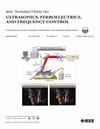A High-Frequency Ultrasound Endoscope for Minimally Invasive Spine Surgery
IF 3.7
2区 工程技术
Q1 ACOUSTICS
IEEE transactions on ultrasonics, ferroelectrics, and frequency control
Pub Date : 2025-04-10
DOI:10.1109/TUFFC.2025.3559870
引用次数: 0
Abstract
The transition to minimally invasive spinal surgery over traditional open procedures requires the development of imaging techniques that meet the size constraints. Due to size restrictions associated with minimally invasive spine surgery (MISS), current imaging techniques are largely limited to microscopy, which is only capable of line-of-sight imaging of the tissue surface. A miniature, high-resolution ultrasound imaging endoscope has been developed as a potential alternative imaging method that would enable intraoperative guidance. We have designed and developed a 30-MHz miniature, 64-element high-resolution imaging endoscope using PIN-PMT-PT single crystal as the piezoelectric substrate. The packaged probe had cross-sectional dimensions of用于微创脊柱手术的高频超声内窥镜。
从传统的开放手术过渡到微创脊柱手术,需要满足尺寸限制的成像技术的发展。由于与微创脊柱手术相关的尺寸限制,目前的成像技术主要局限于显微镜,它只能对组织表面进行视线成像。一种微型、高分辨率超声成像内窥镜已经被开发出来,作为一种潜在的替代成像方法,可以实现术中引导。我们设计并开发了一种30 MHz微型,64元件,高分辨率成像内窥镜,使用PIN-PMT-PT单晶作为压电衬底。封装探头的横截面尺寸为3.8 mm x 4.2 mm,长度为14 cm。内窥镜的两个版本分别具有正面和40⁰角度,以便在内侧和外侧入路期间分别实现结构的可视化。该探头与定制成像系统相结合,产生实时图像,视场范围在±32⁰之间,图像深度为15 mm。基于-6 dB的脉冲包络宽度,测量出双向轴向分辨率为38 μm。在0⁰、12⁰和25⁰的转向角度下,测量到的-6 dB横向分辨率分别为113 μm、131 μm和158 μm,接近106 μm、118 μm和144 μm的模拟值。初步的临床影像学研究成功地证明了在微创手术中相关脊柱解剖的可视化。成像探针还能够显示神经根的压迫和减压,支持其作为临床工具的潜在用途。
本文章由计算机程序翻译,如有差异,请以英文原文为准。
求助全文
约1分钟内获得全文
求助全文
来源期刊
CiteScore
7.70
自引率
16.70%
发文量
583
审稿时长
4.5 months
期刊介绍:
IEEE Transactions on Ultrasonics, Ferroelectrics and Frequency Control includes the theory, technology, materials, and applications relating to: (1) the generation, transmission, and detection of ultrasonic waves and related phenomena; (2) medical ultrasound, including hyperthermia, bioeffects, tissue characterization and imaging; (3) ferroelectric, piezoelectric, and piezomagnetic materials, including crystals, polycrystalline solids, films, polymers, and composites; (4) frequency control, timing and time distribution, including crystal oscillators and other means of classical frequency control, and atomic, molecular and laser frequency control standards. Areas of interest range from fundamental studies to the design and/or applications of devices and systems.

 求助内容:
求助内容: 应助结果提醒方式:
应助结果提醒方式:


